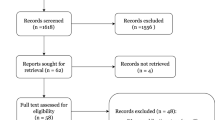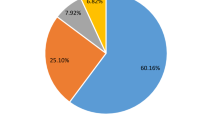Abstract
Study design:
Retrospective analysis of civilians with spinal cord injuries (SCIs) due to terror explosions.
Objectives:
To analyze and describe the clinical characteristics and rehabilitation outcomes of civilians with SCI due to explosions admitted for in-patient rehabilitation from 2000–2004.
Setting:
SCI rehabilitation service, Tel Hashomer, Israel.
Methods:
Retrospective chart review. Civilians with SCI due to terror-related gunshot wounds (GSWs) served as a control group.
Results:
Eleven civilians with SCI caused by penetrating atypical foreign objects (PAFOs) and eight with GSWs were identified. The male-to-female ratio was approximately 2:1. Foreign objects were present within the spinal canal in seven patients, causing bone injury without canal penetration in three, and one patient had both bone injury and canal penetration. The most common level of injury was thoracic. Seven had complete motor SCI. Three individuals improved in American Spinal Injury Association status: one individual improved from B to C (cervical); one from C to D (thoracic); and the third from D to E (lumbar). Despite the similar acute hospital length of stay and functional independence measure (FIM) scores on admission, the PAFO group had a shorter rehabilitation length of stay with higher FIM scores and higher FIM efficiency at discharge.
Conclusions:
Although the pathophysiology of PAFO blast injuries is similar to the high-velocity GSWs or the high-energy military munition injuries, better rehabilitation outcomes were seen, with slightly higher FIM efficiency and efficacy at discharge. This result is likely to be caused by less neurological tissue damage at impact.
Similar content being viewed by others
Log in or create a free account to read this content
Gain free access to this article, as well as selected content from this journal and more on nature.com
or
References
Zeilig G, Weingarden H, Laufer R, Brezner A, Navon A . Terror and rehabilitation of two family members with spinal cord injury. Isr Med Assoc J 2002; 4: 563.
Schwartz I, Tsenter J, Shochina M, Shiri S, Kedary M, Katz-Leurer M et al. Rehabilitation outcomes of terror victims with multiple traumas. Arch Phys Med Rehabil 2007; 88: 440–448.
Ackery A, Tator C, Krassioukov A . A global perspective on spinal cord injury epidemiology. J Neurotrauma 2004; 21: 1355–1370.
Wightman JM, Gladish SL . Explosions and blast injuries. Ann Emerg Med 2001; 37: 664–678.
Bell RS, Vo AH, Neal CJ, Tigno J, Roberts R, Mossop C et al. Military traumatic brain and spinal column injury: a 5-year study of the impact blast and other military grade weaponry on the central nervous system. J Trauma 2009; 66 (4 Suppl): S104–S111.
Weaver FM, Burns SP, Evans CT, Rapacki LM, Goldstein B, Hammond MC . Provider perspectives on soldiers with new spinal cord injuries returning from Iraq and Afghanistan. Arch Phys Med Rehabil 2009; 90: 517–521.
American Spinal Injury Association and International Medical Society of Paraplegia. Standards for Neurological and Functional Classification of Spinal Injury, Revised 1996. American Spinal Injury Association: Chicago, 1996.
State University of New York at Buffalo, School of Medicine and Biomedical Sciences, Center for Functional Assessment Research, Uniform Data System For Medical Rehabilitation. Guide for the Uniform Data Set for Medical Rehabilitation (Adult FIM), Version 4.0, State University of New York: New York, 1993.
Granger CV, Hamiltom BB . The uniform data system for medical rehabilitation. Report of first admissions for 1991. Am J Phys Med Rehabil 1993; 72: 33–38.
Cooper GJ, Ryan J . Interaction of penetrating missiles with tissues: some common misapprehensions and implications for wound management. Br J Surg 1990; 77: 606–610.
DePalma RG, Burris DG, Champion HR, Hodgson MJ . Blast injuries. N Engl J Med 2005; 352: 1335–1342.
Finkel MF . The neurological consequences of explosives. J Neurological Sci 2006; 249: 63–67.
Coupland RM . Technical aspects of war wound excision. Br J Surg 1989; 76: 663–667.
Ryan JM, Milner SM, Cooper GJ, Haywood IR . Field surgery on a future conventional battlefield: strategy and wound management. Ann R Coll Surg Eng 1991; 73: 13–20.
Saadia R, Schein M . Debridement of gunshot wounds: semantics and surgery. World J Surg 2000; 24: 1146–1149.
Owens BD, Kragh Jr JF, Wenke JC, Macaitis J, Wade CE, Holcomb JB . Combat wounds in operation Iraqi freedom and operation enduring freedom. J Trauma 2008; 64: 295–299.
Author information
Authors and Affiliations
Corresponding author
Ethics declarations
Competing interests
The authors declare no conflict of interest.
Rights and permissions
About this article
Cite this article
Zeilig, G., Weingarden, H., Zwecker, M. et al. Civilian spinal cord injuries due to terror explosions. Spinal Cord 48, 814–818 (2010). https://doi.org/10.1038/sc.2010.22
Received:
Revised:
Accepted:
Published:
Issue date:
DOI: https://doi.org/10.1038/sc.2010.22



